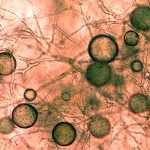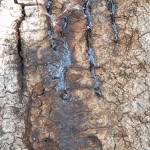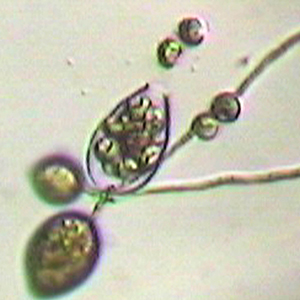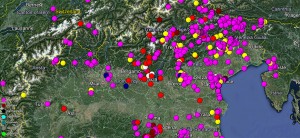Most likely the redwood is experiencing symptoms related to cycles between drought and rainy periods. However, if there is a significant presence of California bay laurels intermixed with redwoods, there may be enough pressure from the SOD pathogen to also cause problems on redwoods, both native and exotic. Any SOD oak infections are likely directly connected to bay laurels, as both oaks and redwoods can become infected by the large number of spores produced on bay laurel leaves. The pathogen does not move from oaks to other trees.
When treating oak trees with phosphites to help prevent SOD, it may be beneficial to apply the topical treatment to bark that is dry. Rain occurring after the treatment (even immediately after) does not affect the application. If injecting phosphites, it may be better to avoid rainy days, as lower evapotranspiration is often documented for trees in such conditions. Lower evapotranspiration rates may result in poor tree absorption of phosphites.
Note: Topical treatments are most effective when applied in the fall, from November to early December. Injections should only be performed from fall to early winter.
Survival of P. ramorum (SOD pathogen) in wood chips depends on a few factors:
- Were the chips allowed to become wet?
- What size are the chips?
- Is green waste present?
- What time of year was the wood chipped?
- Where in California are the chips located?
Chips that are piled wet or tarped and include infected green waste (e.g. bay laurel leaves) may support pathogen viability for over 1 year, especially in mild coastal areas. If the wood is chipped in the summer and early fall and the chips are not piled, but rather broadcast in a 1-inch layer in a dry and sun-exposed area, pathogen viability may only be supported for a few weeks, especially if in hotter interior areas.
Survival of P. ramorum (SOD pathogen) in dead hosts or non-plant substrates is extremely variable and strongly affected by climatic factors. Although a comprehensive study on this topic has not conducted, extrapolating from several studies we can say the following:
Soil becomes more infectious from late winter to early summer in the presence of rainfall, so any movement of soil away from a SOD-infested area from January to July could transport viable P. ramorum.
Keep the following in mind:
- The larger the volume of soil moved, the greater the risk.
- In organic rich soils (e.g. top layers of forest soils), pathogen survival is less than 18 months.
- If P. ramorum is present in green waste incorporated in the soil, survival can be much longer (2 years or more).
- In inert soils (e.g. potting mix), the pathogen can survive multiple years. However, for all soils, areas with less temperate climates (cold winters, hot summers) may hasten loss of pathogen viability.
From a practical perspective, if infested forest soil is picked up on tires or shoes from late winter to early summer, the pathogen will likely remain viable for about 1 year, in the absence of incorporated green waste. If soil is picked up from late summer to early fall, survival duration is much less, possibly in the order of a few months.
Leaf tip scorch symptoms on redwood trees are found from the lower to upper canopy and include healthy leaves interspersed with brown and grey leaves or portions of leaves. Grey leaves typically have black margins into the healthy tissue.
Such symptoms are typically caused by a fungus called Pestalotiopsis funerea. They are commonly associated with drought, when rainfall occurs or when there is overhead watering around the tree. Drought stress predisposes plants to being infected, so the increased moisture facilitates the infection process. Normally the fungus will only seriously affect sprouts, as branches of adult tress will regrow areas killed by the infection within a year. In nursery settings it is important to increase ventilation and avoid big differences in watering regimes to minimize symptoms.
Once bark beetles attack the main stem (trunk) of an oak, the tree is on its way out. Insecticide treatments will not save it. Oak beetles are attracted to trees that are severely compromised. They cannot attack healthy trees.
The correct approach to avoid bark beetle infestations is not to apply insecticides, but rather to identify any health issues a tree may have. As of October 2015, many trees are suffering from the prolonged drought and may need watering. Watering should be applied infrequently and never during the summer. Water-starved trees may display a thinner crown, with olive-green rather than dark-green leaves. Leaves may also be crisp when folded between your fingers. If you opt to provide water to an oak tree that is severely water deprived, make sure the water reaches a depth of about one foot below the soil surface. Also make sure the flow is low to avoid flooding the base of the tree.
Although there may be few insects flying in the winter, the wet winter season (actually fall through spring) is a prime time for production of fruiting bodies by many wood decay fungi. The combination of fresh pruning wounds (especially large wounds), high spore densities of wood decay fungi, and moist conditions (favoring spore germination) can favor new infections by these fungi. From the standpoint of reducing risk of infection by wood decay fungi, pruning in late spring or early summer is probably preferable.
In general, pruning live branches from mature oaks should be kept to a minimum. However, if it is necessary to prune coast live oak branches, as long as they are less than 4″ in diameter, the presence of SOD is not a concern. Though, it is important to prune the oak correctly.
• Make sure you prune right where the tapering of the branch ends from the main stem or even slightly closer to the stem (1/2 in. from the end of the tapering towards the stem).
• Make sure the cut is clean and allows for water to drip without accumulating.
Once down, spores from bay foliage will not travel nearly as far as they do in the canopy. The concern on the ground is that infested leaves, while still fresh, could have spores picked up during a wet event from soil splash onto the trunk of the tree. So, spread bay foliage in a thin layer in a sunny area that will promote drying. Be sure to not have foliage near the base of oak or tanoak trunks where soil splash/infection could occur.

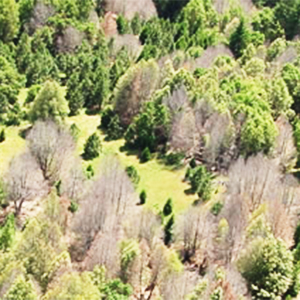
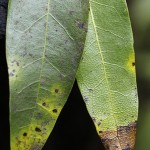 SOD is an exotic disease caused by the microscopic pathogen Phytophthora ramorum, estimated to have been introduced into California 20-25 years ago from unknown region of the world.
SOD is an exotic disease caused by the microscopic pathogen Phytophthora ramorum, estimated to have been introduced into California 20-25 years ago from unknown region of the world.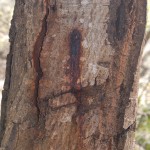 and a foliar infection. Tanoaks are the only tree species that can spread the the disease and die from it as well. When P. ramorum infects oaks and tanoaks it destroys the cambium under the bark and effectively girdles the tree. Girdled trees are doomed, but can survive for 1 to 5+ years thanks to stored resources and their natural tolerance to drought.
and a foliar infection. Tanoaks are the only tree species that can spread the the disease and die from it as well. When P. ramorum infects oaks and tanoaks it destroys the cambium under the bark and effectively girdles the tree. Girdled trees are doomed, but can survive for 1 to 5+ years thanks to stored resources and their natural tolerance to drought.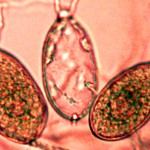 percipitation.
percipitation.